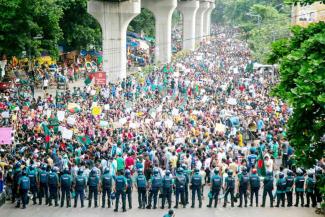Bangladesh is witnessing a historic student upheaval. What triggered the unrest was a High Court verdict restoring the old quota system in government jobs, but what has evidently led to the intensification of the movement and its spread like a wild fire across university campuses and district towns of Bangladesh is the government's attempt to suppress the movement by unleashing state terror and extra-judicial violence. Evidently the movement is striking wider chords beyond the student community and the issue of quota and fuelling the deeper urge for democracy and change.
Bangladesh had 56% quota in government jobs - 1% for candidates with disability, 5% for ethnic minorities, 10% for districts, 10% for women and 30% for descendants of liberation war fighters. In 2018 there was a popular movement against this quota framework, especially the 30% reservation for liberation war families which is widely perceived as a partisan political privilege for the ruling Awami League. In the face of this agitation, the Hasina government had drastically changed the quota system, cancelling all the categories except the 1% quota for people with disabilities and 5% for candidates from ethnic minorities. A legal battle ensued and on June 5 came the High Court order restoring the old system. While the students started protesting, the government too has appealed against the High Court order at the Supreme Court and the Supreme Court verdict is awaited.
Why did the government choose to suppress the students by violent means when the government seems to be in substantive agreement with the students on the quota issue? The number of students killed in state repression and violence perpetrated by state-patronised goons of the ruling party and its student-youth organisations is believed to run into dozens. The video of 25-year-old Abu Sayeed of Begum Rokeya University of Rangpur being shot down by the police has gone viral. To justify this repression the Hasina government has also branded the protesting students as Rajakars, the collaborators who had joined hands with Pakistan during the liberation war of Bangladesh, a label akin to the anti-national tag routinely invoked by the Sangh brigade against dissenters in India.
The anti-quota discourse in India has a distinct elitist overtone of caste privilege. Merit is invoked as a customary cultural capital of the privileged and increasingly as a commodity meant for appropriation by the rich. In Bangladesh the popular discontent seems to be against partisan misuse of the quota system, nepotism and the ruling party's use of the liberation war as an exclusive political legacy. The main opposition is against quotas for second and third generation descendants of freedom fighters rather than other quotas. And it is not just about the quotas, students in Bangladesh are facing the same kind of corruption in the system of education, examination and recruitment just as Indian students are having to grapple with scam-ridden NEET and UPSC system. And unemployment in Bangladesh is also as severe as in India.
As we go to press the situation seems to be deteriorating rapidly in Bangladesh. The death toll is rising alarmingly, curfew has been clamped down coupled with internet shutdown and talks of military deployment. Given the shrinking democratic space and lack of credibility of recent electoral exercises, the anger of the people is understandably quite explosive. Various forces and tendencies, including diverse fundamentalist streams, are bound to be present in such a broad popular upheaval. Students and secular democratic forces in India of course stand in solidarity with the protesting students of Bangladesh, condemn the state-sponsored violence and wish Bangladesh to find a democratic solution to the current crisis.











